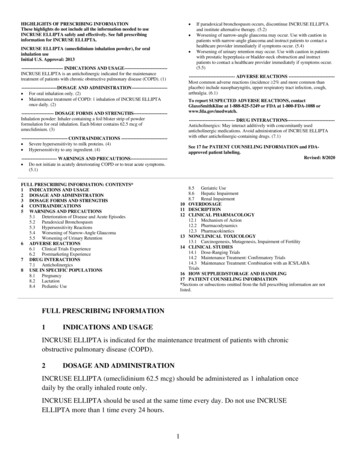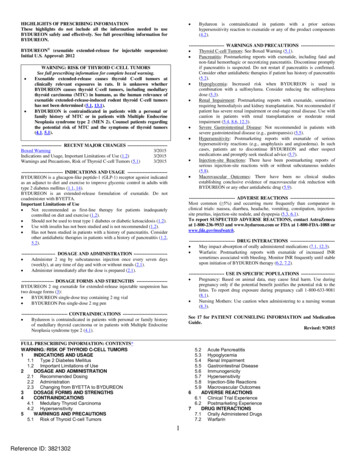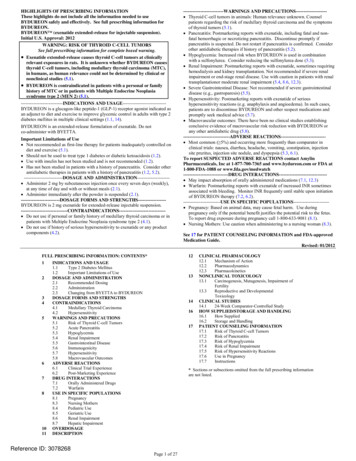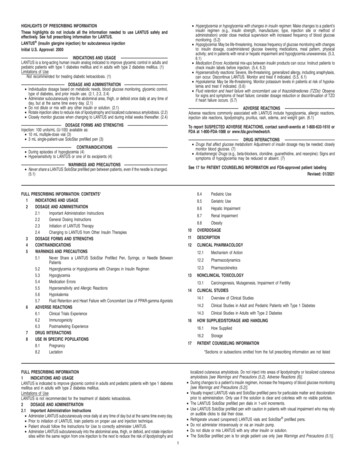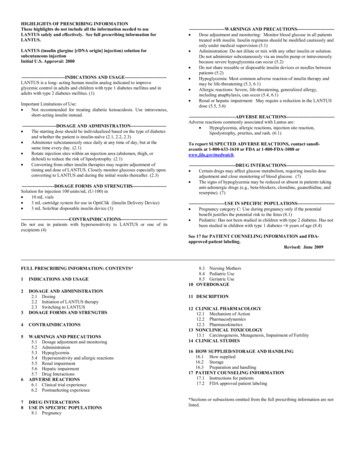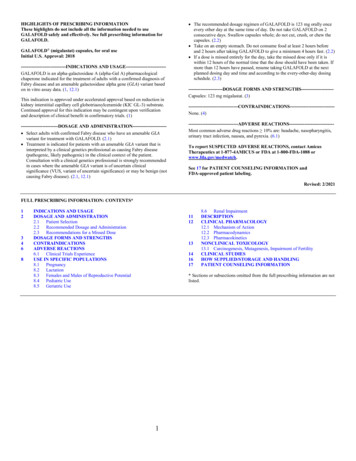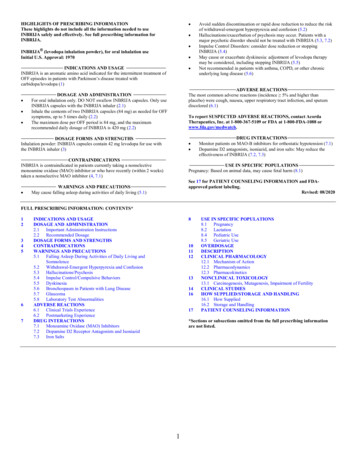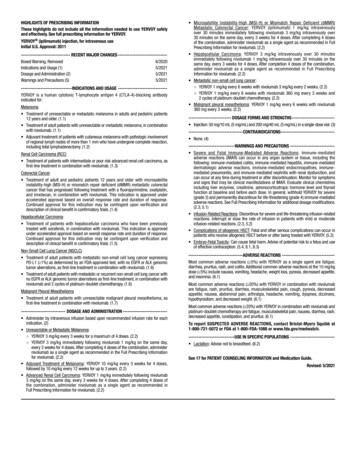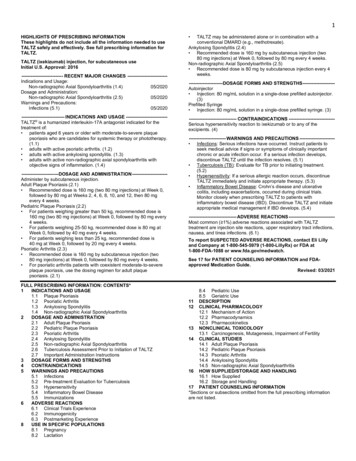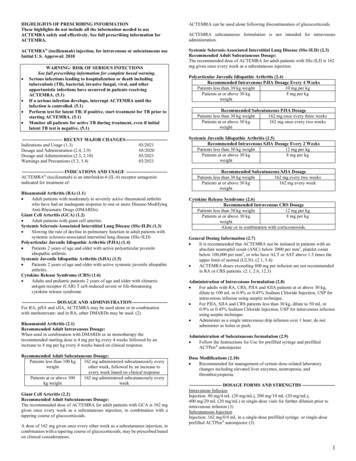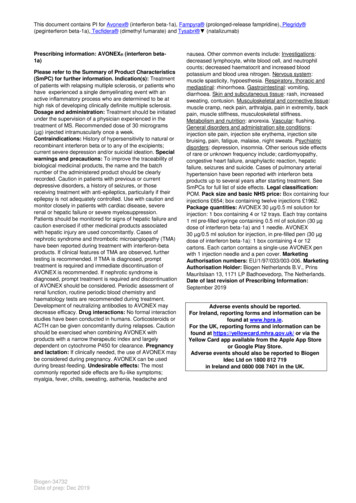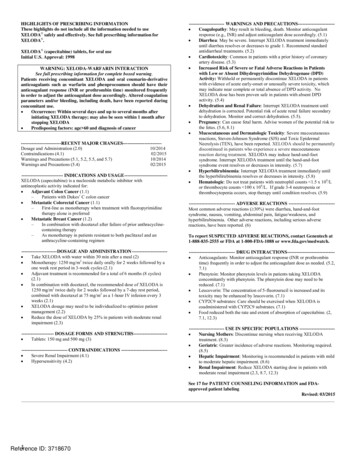
Transcription
HIGHLIGHTS OF PRESCRIBING INFORMATIONThese hig hlights do not include all the informatio n nee ded to useXELODA safely and effectively. See full prescribing information forXELODA .XELODA (capecitabine) tablets, for oral useInitial U.S. Approval: 1998WARNING: XELODA-WARFARIN INTERACTIONSee full prescribing information for complete boxed warning.Patients receiving concomitant XELODA and oral coumarin-derivativeanticoagulants such as warfarin and phe nprocoumo n should have theiranticoagulant response (INR or prothrombin time) monitored frequentlyin order to adjust the anticoagulant dose accordingly. Altered coagulationparameters and/or bleeding, including de ath, have been re ported duringconcomitant use. Occurrence: Within several days and up to several mo nths afterinitiating XELODA therapy; may also be seen within 1 month afterstopping XELODA Predisposing factors: age 60 and diagnosis of cancer--------------------------RECENT MAJOR CHANGES------------------------ Dosage and Administration (2.0)10/2014Contraindications (4.1)02/2015Warnings and Precautions (5.1, 5.2, 5.5, and 5.7)10/2014Warnings and Precautions (5.4)02/2015--------------------------- INDICATIONS AND USAGE ---------------------------XELODA (capecitabine) is a nucleoside metabolic inhibitor withantineoplastic activity indicated for: Adjuv ant Colon Cancer (1.1)–Patients with Dukes’ C colon cancer Metastatic Colorectal Cancer (1.1)–First-line as monotherapy when treatment with fluoropyrimidinetherapy alone is preferred Metastatic Breast Cancer (1.2)–In combination with docetaxel after failure of prior anthracyclinecontaining therapy–As monotherapy in patients resistant to both paclitaxel and ananthracycline-containing regimen----------------------- DOSAGE AND ADMINISTRATION ---------------------- Take XELODA with water within 30 min after a meal (2) Monotherapy: 1250 mg/m2 twice daily orally for 2 weeks followed by aone week rest period in 3-week cycles (2.1) Adjuvant treatment is recommended for a total of 6 months (8 cycles)(2.1) In combination with docetaxel, the recommended dose of XELODA is1250 mg/m2 twice daily for 2 weeks followed by a 7-day rest period,combined with docetaxel at 75 mg/m2 as a 1-hour IV infusion every 3weeks (2.1) XELODA dosage may need to be individualized to optimize patientmanagement (2.2) Reduce the dose of XELODA by 25% in patients with moderate renalimpairment (2.3)--------------------- DOSAGE FORMS AND STRENGTHS--------------------- Tablets: 150 mg and 500 mg (3)------------------------------ CONTRAINDICATIONS ----------------------------- Severe Renal Impairment (4.1) Hypersensitivity (4.2)----------------------- WARNINGS AND PRECAUTIONS----------------------- Coagulopathy: May result in bleeding, death. Monitor anticoagulantresponse (e.g., INR) and adjust anticoagulant dose accordingly. (5.1) Diarrhea: May be severe. Interrupt XELODA treatment immediatelyuntil diarrhea resolves or decreases to grade 1. Recommend standardantidiarrheal treatments. (5.2) Cardiotoxicity: Common in patients with a prior history of coronaryartery disease. (5.3) Increased Risk of Severe or Fatal Adverse Reactions in Patientswith Lo w or Absent Dihydropyrimidine Dehydrogenase (DPD)Activity: Withhold or permanently discontinue XELODA in patientswith evidence of acute early-onset or unusually severe toxicity, whichmay indicate near complete or total absence of DPD activity. NoXELODA dose has been proven safe in patients with absent DPDactivity. (5.4) Dehydratio n and Renal Failure: Interrupt XELODA treatment untildehydration is corrected. Potential risk of acute renal failure secondaryto dehydration. Monitor and correct dehydration. (5.5). Pregnancy: Can cause fetal harm. Advise women of the potential risk tothe fetus. (5.6, 8.1) Mucocutaneous and Dermatologic Toxicity: Severe mucocutaneousreactions, Steven-Johnson Syndrome (SJS) and Toxic EpidermalNecrolysis (TEN), have been reported. XELODA should be permanentlydiscontinued in patients who experience a severe mucocutaneousreaction during treatment. XELODA may induce hand-and-footsyndrome. Interrupt XELODA treatment until the hand-and-footsyndrome event resolves or decreases in intensity. (5.7) Hyperbilirubinemia: Interrupt XELODA treatment immediately untilthe hyperbilirubinemia resolves or decreases in intensity. (5.8) Hematologic: Do not treat patients with neutrophil counts 1.5 x 109/Lor thrombocyte counts 100 x 109/L. If grade 3-4 neutropenia orthrombocytopenia occurs, stop therapy until condition resolves. (5.9)------------------------------ ADVERSE REACTIONS -----------------------------Most common adverse reactions ( 30%) were diarrhea, hand-and-footsyndrome, nausea, vomiting, abdominal pain, fatigue/weakness, andhyperbilirubinemia. Other adverse reactions, including serious adversereactions, have been reported. (6)To report SUSPECTED ADVERSE REACTIONS, contact Genentech at1-888-835-2555 or FDA at 1-800-FDA-1088 or - DRUG INTERACTIONS------------------------------ Anticoagulants: Monitor anticoagulant response (INR or prothrombintime) frequently in order to adjust the anticoagulant dose as needed. (5.2,7.1) Phenytoin: Monitor phenytoin levels in patients taking XELODAconcomitantly with phenytoin. The phenytoin dose may need to bereduced. (7.1) Leucovorin: The concentration of 5-fluorouracil is increased and itstoxicity may be enhanced by leucovorin. (7.1) CYP2C9 substrates: Care should be exercised when XELODA iscoadministered with CYP2C9 substrates. (7.1) Food reduced both the rate and extent of absorption of capecitabine. (2,7.1, 12.3)----------------------- USE IN SPECIFIC POPULATIONS ---------------------- Nursing Mothers: Discontinue nursing when receiving XELODAtreatment. (8.3) Geriatric: Greater incidence of adverse reactions. Monitoring required.(8.5) Hepatic Impairment: Monitoring is recommended in patients with mildto moderate hepatic impairment. (8.6) Renal Impairme nt: Reduce XELODA starting dose in patients withmoderate renal impairment (2.3, 8.7, 12.3)See 17 for PATIENT COUNSELING INFORMATION and FDAapproved patient labelingRevised: 03/20151ReferenceID: 3718670
FULL PRESCRIBING INFORMATION: CONTENTS*WARNING: XELODA-WARFARIN INTERACTION1 INDICATIONS AND USAGE1.1 Colorectal Cancer1.2 Breast Cancer2 DOSAGE AND ADMINISTRATION2.1 Standard Starting Dose2.2 Dose Management Guidelines2.3 Adjustment of Starting Dose in Special Populations3 DOSAGE FORMS AND STRENGTHS4 CONTRAINDICATIONS4.1 Severe Renal Impairment4.2 Hypersensitivity5 WARNINGS AND PRECAUTIONS5.1 Coagulopathy5.2 Diarrhea5.3 Cardiotoxicity5.4 Dihydropyrimidine Dehydrogenase Deficiency5.5 Dehydration and Renal Failure5.6 Pregnancy5.7 Mucocutaneous and Dermatologic Toxicity5.8 Hyperbilirubinemia5.9 Hematologic5.10 Geriatric Patients5.11 Hepatic Insufficiency5.12 Combination With Other Drugs6 ADVERSE REACTIONS6.1 Adjuva nt Colon Ca ncer6.2 Metastatic Colorectal Cancer2ReferenceID: 37186707810111213141516176.3 Breast Cancer6.4 Clinically Relevant Adverse Events in 5% of PatientsDRUG INTERACTIONS7.1 Drug-Drug Interactions7.2 Drug-Food Intera ctionUSE IN SPECIFIC POPULATIONS8.1 Pregnancy: Category D8.3 Nursing Mothers8.4 Pediatric Use8.5 Geriatric Use8.6 Hepatic Insufficiency8.7 Renal InsufficiencyOVERDOSAGEDESCRIPTIONCLINICAL PHARMACOLOGY12.1 Mechanism of Action12.3 Pharma cokineticsNONCLINICAL TOXICOLOGY13.1 Carcinogenesis, Mutagenesis, Impairment of FertilityCLINICAL STUDIES14.1 Adjuva nt Colon Ca ncer14.2 Metastatic Colorectal Cancer14.3 Breast CancerREFERENCESHOW SUPPLIED/STORAGE AND HANDLINGPATIENT COUNSELING INFORMATION*Sections or subsections omitted from the full prescribing information are notlisted.
FULL PRESCRIBING INFORMATIONWARNING: XELODA-WARFARIN INTERACTIONXELODA Warfarin Interaction: Patients receiving concomitant capecitabine and oralcoumarin-derivative anticoagulant therapy should have their anticoagulant response (INRor prothrombin time) monitored frequently in order to adjust the anticoagulant doseaccordingly. A clinically important XELODA-Warfarin drug interaction wasdemonstrated in a clinical pharmacology trial [see Warnings and Precautions (5.2) andDrug Interactions (7.1)]. Altered coagulation parameters and/or bleeding, including death,have been reported in patients taking XELODA concomitantly with coumarin-derivativeanticoagulants such as warfarin and phenprocoumon. Postmarketing reports have shownclinically significant increases in prothrombin time (PT) and INR in patients who werestabilized on anticoagulants at the time XELODA was introduced. These events occurredwithin several days and up to several months after initiating XELODA therapy and, in afew cases, within 1 month after stopping XELODA. These events occurred in patients withand without liver metastases. Age greater than 60 and a diagnosis of cancer independentlypredispose patients to an increased risk of coagulopathy.1INDICATIONS AND USAGE1.1Colorectal Cancer XELODA is indicated as a single agent for adjuvant treatment in patients with Dukes’ Ccolon cancer who have undergone complete resection of the primary tumor when treatmentwith fluoropyrimidine therapy alone is preferred. XELODA was non-inferior to 5fluorouracil and leucovorin (5-FU/LV) for disease-free survival (DFS). Physicians shouldconsider results of combination chemotherapy trials, which have shown improvement in DFSand OS, when prescribing single-agent XELODA in the adjuvant treatment of Dukes’ Ccolon cancer. XELODA is indicated as first-line treatment of patients with metastatic colorectal carcinomawhen treatment with fluoropyrimidine therapy alone is preferred. Combination chemotherapyhas shown a survival benefit compared to 5-FU/LV alone. A survival benefit over 5-FU/LVhas not been demonstrated with XELODA monotherapy. Use of XELODA instead of 5FU/LV in combinations has not been adequately studied to assure safety or preservation ofthe survival advantage.1.2Breast Cancer XELODA in combination with docetaxel is indicated for the treatment of patients withmetastatic breast cancer after failure of prior anthracycline-containing chemotherapy. XELODA monotherapy is also indicated for the treatment of patients with metastatic breastcancer resistant to both paclitaxel and an anthracycline-containing chemotherapy regimen orresistant to paclitaxel and for whom further anthracycline therapy is not indicated (e.g.,patients who have received cumulative doses of 400 mg/m2 of doxorubicin or doxorubicinequivalents). Resistance is defined as progressive disease while on treatment, with or withoutan initial response, or relapse within 6 months of completing treatment with an anthracyclinecontaining adjuvant regimen.3 3718670Reference ID:
2DOSAGE AND ADMINISTRATIONXELODA tablets should be swallowed whole with water within 30 minutes after a meal. Do notcrush or cut XELODA tablets. XELODA dose is calculated according to body surface area.2.1Standard Starting DoseMonotherapy (Metastatic Colorectal Cancer, Adjuvant Colorectal Cancer, Metastatic BreastCancer)The recommended dose of XELODA is 1250 mg/m2 administered orally twice daily (morningand evening; equivalent to 2500 mg/m2 total daily dose) for 2 weeks followed by a 1-week restperiod given as 3-week cycles (see Table 1).Adjuvant treatment in patients with Dukes’ C colon cancer is recommended for a total of 6months [ie, XELODA 1250 mg/m2 orally twice daily for 2 weeks followed by a 1-week restperiod, given as 3-week cycles for a total of 8 cycles (24 weeks)].Table 1XELODA Dose Calculation According to Body Surface AreaDose Level 1250 mg/m2Number of Tablets to be Taken atTwice a DayEach Dose (Morning and Evening)Surface AreaTotal Daily150 mg500 mg2(m )Dose* (mg)300003 .17530015560025 2.18*Total Daily Dose divided by 2 to allow equal morning and evening dosesIn Combination With Docetaxel (Metastatic Breast Cancer)In combination with docetaxel, the recommended dose of XELODA is 1250 mg/m2 twice dailyfor 2 weeks followed by a 1-week rest period, combined with docetaxel at 75 mg/m2 as a 1-hourintravenous infusion every 3 weeks. Pre-medication, according to the docetaxel labeling, shouldbe started prior to docetaxel administration for patients receiving the XELODA plus docetaxelcombination. Table 1 displays the total daily dose of XELODA by body surface area and thenumber of tablets to be taken at each dose.2.2Dose Management GuidelinesGeneralXELODA dosage may need to be individualized to optimize patient management. Patientsshould be carefully monitored for toxicity and doses of XELODA should be modified asnecessary to accommodate individual patient tolerance to treatment [see Clinical Studies (14)].Toxicity due to XELODA administration may be managed by symptomatic treatment, doseinterruptions and adjustment of XELODA dose. Once the dose has been reduced, it should not be4 3718670Reference ID:
increased at a later time. Doses of XELODA omitted for toxicity are not replaced or restored;instead the patient should resume the planned treatment cycles.The dose of phenytoin and the dose of coumarin-derivative anticoagulants may need to bereduced when either drug is administered concomitantly with XELODA [see Drug Interactions(7.1)].Monotherapy (Metastatic Colorectal Cancer, Adjuvant Colorectal Cancer, Metastatic BreastCancer)XELODA dose modification scheme as described below (see Table 2) is recommended for themanagement of adverse reactions.Table 2ToxicityNCIC Grades*Grade 1Recommended Dose Modifications of XELODADuring a Course of TherapyDose Adjustment for NextTreatment (% of starting dose)Maintain dose levelMaintain dose levelGrade 2-1st appearance-2nd appearance-3rd appearance-4th appearanceInterrupt until resolved to grade 0-1Discontinue treatment permanently100%75%50%-Grade 3-1st appearance-2nd appearance-3rd appearanceInterrupt until resolved to grade 0-1Discontinue treatment permanently75%50%-Grade 4-1st appearanceDiscontinue permanently50%ORIf physician deems it to be in thepatient’s best interest to continue,interrupt until resolved to grade 0-1*National Cancer Institute of Canada Common Toxicity Criteria were used except for the hand-and-foot syndrome[see Warnings and Precautions (5)].In Combination With Docetaxel (Metastatic Breast Cancer)Dose modifications of XELODA for toxicity should be made according to Table 2 above forXELODA. At the beginning of a treatment cycle, if a treatment delay is indicated for eitherXELODA or docetaxel, then administration of both agents should be delayed until therequirements for restarting both drugs are met.The dose reduction schedule for docetaxel when used in combination with XELODA for thetreatment of metastatic breast cancer is shown in Table 3.5 3718670Reference ID:
Table 3ToxicityDocetaxel Dose Reduction Schedule in Combination with XELODAGrade 2Grade 3Grade 4NCIC Grades*1st appearanceDelay treatment untilDelay treatment untilDiscontinue treatmentresolved to grade 0-1;resolved to grade 0-1;with docetaxelResume treatment withResume treatment atoriginal dose of 75 mg/m255 mg/m2 of docetaxel.docetaxel2nd appearanceDelay treatment untilDiscontinue treatmentresolved to grade 0-1;with docetaxelResume treatment at55 mg/m2 of docetaxel.3rd appearanceDiscontinue treatment withdocetaxel*National Cancer Institute of Canada Common Toxicity Criteria were used except for hand-and-foot syndrome [seeWarnings and Precautions (5)].2.3Adjustment of Starting Dose in Special PopulationsRenal ImpairmentNo adjustment to the starting dose of XELODA is recommended in patients with mild renalimpairment (creatinine clearance 51 to 80 mL/min [Cockroft and Gault, as shown below]). Inpatients with moderate renal impairment (baseline creatinine clearance 30 to 50 mL/min), adose reduction to 75% of the XELODA starting dose when used as monotherapy or incombination with docetaxel (from 1250 mg/m2 to 950 mg/m2 twice daily) is recommended [seeUse in Specific Populations (8.7) and Clinical Pharmacology (12.3)]. Subsequent doseadjustment is recommended as outlined in Table 2 and Table 3 (depending on the regimen) if apatient develops a grade 2 to 4 adverse event [see Warnings and Precautions (5.5)]. The startingdose adjustment recommendations for patients with moderate renal impairment apply to bothXELODA monotherapy and XELODA in combination use with docetaxel.Cockroft and Gault Equation:(140 - age [yrs]) (body wt [kg])Creatinine clearance for males —————————————(72) (serum creatinine [mg/dL])Creatinine clearance for females 0.85 x male valueGeriatricsPhysicians should exercise caution in monitoring the effects of XELODA in the elderly.Insufficient data are available to provide a dosage recommendation.3DOSAGE FORMS AND STRENGTHSXELODA is supplied as biconvex, oblong film-coated tablets for oral administration. Each lightpeach-colored tablet contains 150 mg of capecitabine and each peach-colored tablet contains 500mg of capecitabine.6 3718670Reference ID:
4CONTRAINDICATIONS4.1Severe Renal ImpairmentXELODA is contraindicated in patients with severe renal impairment (creatinine clearancebelow 30 mL/min [Cockroft and Gault]) [see Use in Specific Populations (8.7) and ClinicalPharmacology (12.3)].4.2HypersensitivityXELODA is contraindicated in patients with known hypersensitivity to capecitabine or to any ofits components. XELODA is contraindicated in patients who have a known hypersensitivity to 5fluorouracil.5GeneralWARNINGS AND PRECAUTIONSPatients receiving therapy with XELODA should be monitored by a physician experienced in theuse of cancer chemotherapeutic agents. Most adverse reactions are reversible and do not need toresult in discontinuation, although doses may need to be withheld or reduced [see Dosage andAdministration (2.2)].5.1CoagulopathyPatients receiving concomitant capecitabine and oral coumarin-derivative anticoagulant therapyshould have their anticoagulant response (INR or prothrombin time) monitored closely with greatfrequency and the anticoagulant dose should be adjusted accordingly [see Boxed Warning andDrug Interactions (7.1)].5.2DiarrheaXELODA can induce diarrhea, sometimes severe. Patients with severe diarrhea should becarefully monitored and given fluid and electrolyte replacement if they become dehydrated. In875 patients with either metastatic breast or colorectal cancer who received XELODAmonotherapy, the median time to first occurrence of grade 2 to 4 diarrhea was 34 days (rangefrom 1 to 369 days). The median duration of grade 3 to 4 diarrhea was 5 days. National CancerInstitute of Canada (NCIC) grade 2 diarrhea is defined as an increase of 4 to 6 stools/day ornocturnal stools, grade 3 diarrhea as an increase of 7 to 9 stools/day or incontinence andmalabsorption, and grade 4 diarrhea as an increase of 10 stools/day or grossly bloody diarrheaor the need for parenteral support. If grade 2, 3 or 4 diarrhea occurs, administration of XELODAshould be immediately interrupted until the diarrhea resolves or decreases in intensity to grade 1[see Dosage and Administration (2.2)]. Standard antidiarrheal treatments (eg, loperamide) arerecommended.Necrotizing enterocolitis (typhlitis) has been reported.5.3CardiotoxicityThe cardiotoxicity observed with XELODA includes myocardial infarction/ischemia, angina,dysrhythmias, cardiac arrest, cardiac failure, sudden death, electrocardiographic changes, andcardiomyopathy. These adverse reactions may be more common in patients with a prior historyof coronary artery disease.7 3718670Reference ID:
5.4Dihydropyrimidine Dehydrogenase DeficiencyBased on postmarketing reports, patients with certain homozygous or certain compoundheterozygous mutations in the DPD gene that result in complete or near complete absence ofDPD activity are at increased risk for acute early-onset of toxicity and severe, life-threatening,or fatal adverse reactions caused by XELODA (e.g., mucositis, diarrhea, neut
7.1 12 13.1 2 5.11 6 full prescribing information: contents* warning: xeloda -warfarin int
